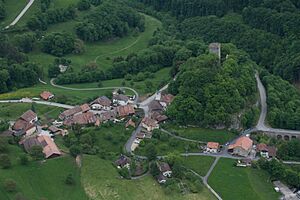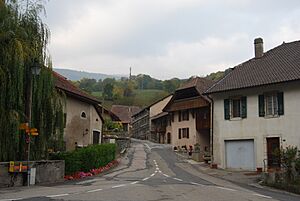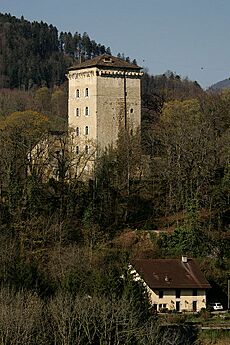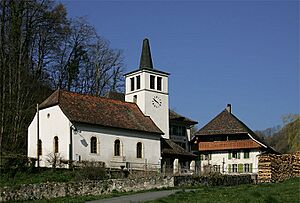Les Clées facts for kids
Quick facts for kids
Les Clées
|
||
|---|---|---|
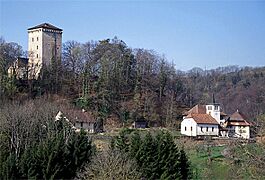
Les Clées castle above the village
|
||
|
||
| Country | Switzerland | |
| Canton | Vaud | |
| District | Jura-Nord Vaudois | |
| Area | ||
| • Total | 7.04 km2 (2.72 sq mi) | |
| Elevation | 605 m (1,985 ft) | |
| Population
(Dec 2020 )
|
||
| • Total | 187 | |
| • Density | 26.56/km2 (68.80/sq mi) | |
| Demonym(s) | Les Bourdons Les Moustiques |
|
| Postal code |
1356
|
|
| Localities | La Russille | |
| Surrounded by | L'Abergement, Sergey, Montcherand, Agiez, Bretonnières, Premier, Vallorbe, Ballaigues, Lignerolle | |
Les Clées is a small town, also called a municipality, located in the Jura-Nord Vaudois area of the canton of Vaud in Switzerland. It's known for its historic castle ruins.
Contents
History of Les Clées
Les Clées was first mentioned in old records in 1134. Its name back then was Clees.
The Castle and Its Importance
Above the village, you can still see the remains of Les Clées Castle. The main tower, called a keep, was fixed up in the 1800s, but the rest of the castle is still in ruins. During the Middle Ages, Les Clées was an important city. In 1272, the Count of Savoy gave the city many special freedoms.
The city became rich because of the busy trade route that passed through the Jougne Pass. The castle collected money, called tolls, from everyone using this road. From 1536, Les Clées became part of the bailiwick (an area ruled by a special officer) of Yverdon.
Changes Over Time
Les Clées was the main town of its own district, which included eight other villages. For a while, from the 1400s to 1566, the Vallée de Joux also belonged to this district.
In 1134, Pope Innocent II tried to stop the castle from being rebuilt, but he wasn't successful. Over the years, different powerful leaders, like the Duke of Burgundy and the Count of Geneva, tried to control the area. Eventually, in 1260, the Count of Geneva lost control to Peter of Savoy.
In 1272, a deal was made between Count Philip I of Savoy and the dean of Romainmôtier. This deal meant the castle of Les Clées would protect the monastery and its lands. People living there had to pay a tax for this protection until 1798.
During the Burgundian Wars on October 22, 1475, soldiers from the Swiss Confederation attacked and destroyed the city and castle. They also killed the castle's soldiers. Later, under Bernese rule (when Bern controlled the area), there were three courts in the Les Clées district, and one was in the city. However, the city slowly became less important over time.
Village Buildings
The chapel in Les Clées was built before the 1300s. It was a smaller church connected to the main parish of Lignerolle. It stayed that way even after the Protestant Reformation (a big change in Christianity). The chapel was rebuilt between 1738 and 1740.
From the late 1400s to the early 1700s, there was a furnace and a place to melt pig iron (a type of iron) in the village. In 1990, a new highway connecting Vallorbe and Lausanne was built, which split the community into two parts.
Geography of Les Clées
Les Clées covers an area of about 7 square kilometers (about 2.7 square miles). A large part of this land, about 24%, is used for farming. Even more, about 70%, is covered by forests. The rest of the land, about 5.4%, has buildings or roads. A small part, about 1%, is made up of rivers or lakes.
Most of the built-up area is for homes and other buildings. About 3.8% is for roads and other ways to get around. In the forested areas, most of the land is covered with thick forests, and a small part has orchards or groups of trees. For farming, some land is used for growing crops, and some is for pastures where animals graze. All the water in Les Clées is from flowing rivers and streams.
Until August 31, 2006, Les Clées was part of the Orbe District. After that, it became part of the new Jura-Nord Vaudois district.
The municipality of Les Clées includes the main village of Les Clées and a smaller village called a hamlet named La Russille.
Coat of Arms
The official design for the municipal coat of arms of Les Clées is a red shield with a silver fence on it.
Population of Les Clées
Les Clées has a population of 153 people (as of 2023). About 7.9% of the people living here are foreign nationals. Over the last ten years (from 1999 to 2009), the population grew by about 3.9%. This growth was mostly because more people moved into the area than moved out.
Most people in Les Clées, about 94.2%, speak French. German is the second most common language, spoken by about 3.9% of the population.
In 2009, the age groups in Les Clées were:
- Children (0-9 years old): 9.3%
- Teenagers (10-19 years old): 11.2%
- Young adults (20-29 years old): 10.6%
- Adults (30-59 years old): 48.4%
- Seniors (60 years and older): 19.8%
In 2000, there were 60 private homes in Les Clées, with about 2.6 people living in each home on average. About 25% of these homes had only one person living in them.
Most of the buildings in Les Clées are single-family homes. In 2000, about 93.8% of the apartments were lived in all the time.
The chart below shows how the population of Les Clées has changed over many years:

Important Heritage Sites
Les Clées Castle, along with its surrounding ruins and the village itself, is considered a very important heritage site of national significance in Switzerland. This means it's a special place that is protected because of its history and culture. The small village of La Russille and the wider Les Clées region are also listed as important heritage sites.
Economy and Jobs
In 2010, the unemployment rate in Les Clées was 4.5%. This means a small percentage of people looking for jobs couldn't find them.
Types of Jobs
In 2008, people in Les Clées worked in different types of jobs:
- Primary Sector: This includes jobs like farming. About 8 people worked in this sector, with 4 businesses.
- Secondary Sector: This includes jobs like manufacturing and construction. About 9 people worked in this sector, with 2 businesses. Most of these jobs (7 out of 8) were in construction.
- Tertiary Sector: This includes jobs that provide services, like sales, restaurants, and education. About 10 people worked in this sector, with 3 businesses. Most of these jobs (6 out of 8) were in sales or vehicle repair, and 2 were in education.
In total, 76 people living in Les Clées had jobs, and about 36.8% of them were women.
Commuting to Work
In 2000, only 6 workers came into Les Clées for their jobs, while 55 workers left the municipality to work somewhere else. This means many more people leave Les Clées for work than come in. About 6.6% of working people used public transportation, and 68.4% used a private car to get to work.
Religion in Les Clées
According to the 2000 census:
- About 12.3% of the population were Roman Catholic.
- About 69.5% belonged to the Swiss Reformed Church (a type of Protestant church).
- About 12.99% belonged to other Christian churches.
- About 1.30% were Islamic.
- About 10.39% did not belong to any church, or were agnostic (not sure if God exists) or atheist (do not believe in God).
Education in Les Clées
In Les Clées, about 40.3% of the population have finished non-mandatory upper secondary education (like high school). About 11.7% have gone on to higher education, either at a university or a specialized college (called a Fachhochschule).
School System
In the 2009/2010 school year, there were 17 students in the Les Clées school district. In the Vaud canton (state) school system, children can attend two years of non-required pre-school. The canton helps pay for pre-school for many children.
The main primary school program in the canton lasts for four years. There were 8 students in the primary school program in Les Clées. After primary school, there is an obligatory lower secondary school program that lasts for six years, and 9 students were in these schools.
In 2000, 14 students came to Les Clées to attend school from other towns, while 31 students from Les Clées went to schools outside the municipality.
See also
 In Spanish: Les Clées para niños
In Spanish: Les Clées para niños





